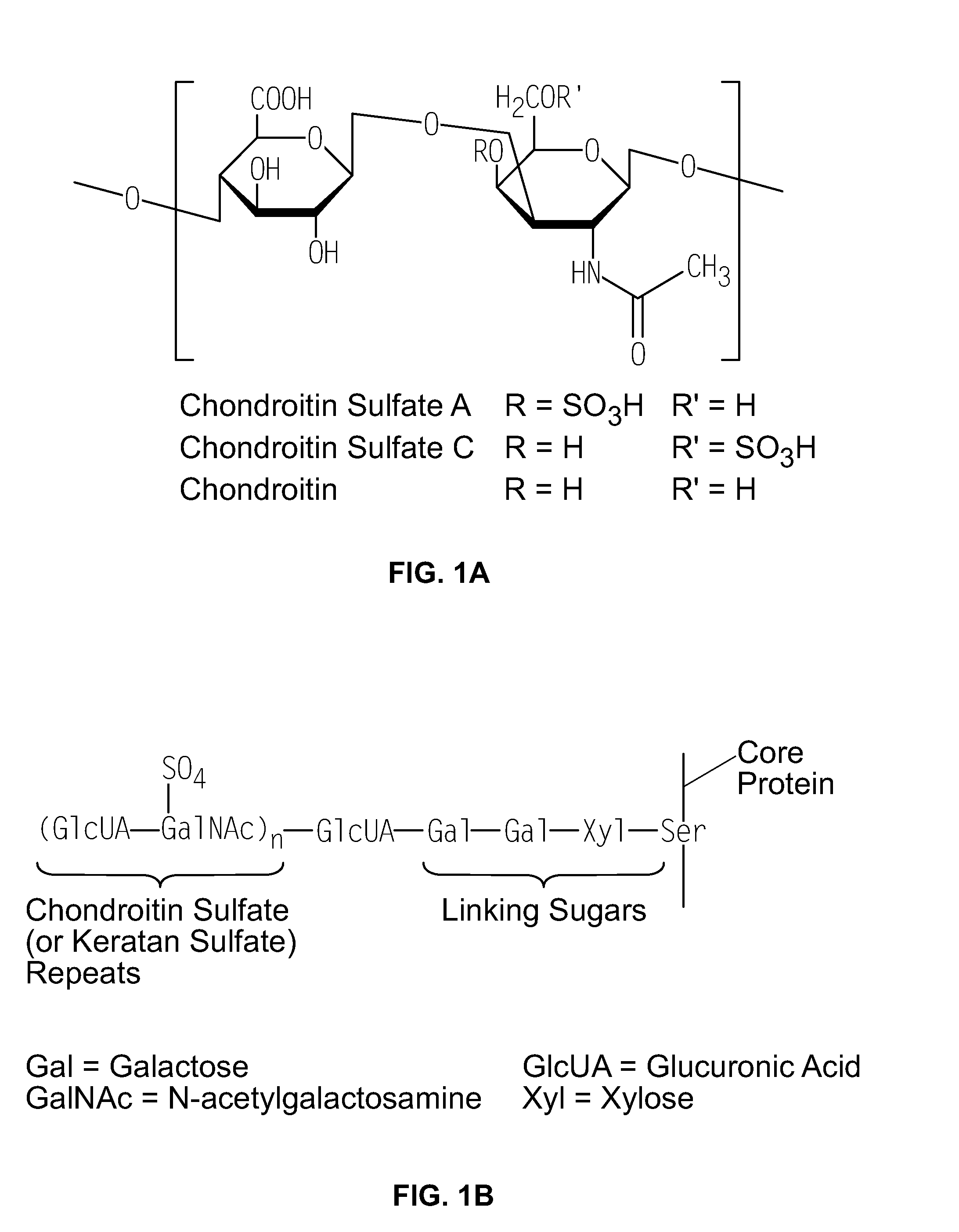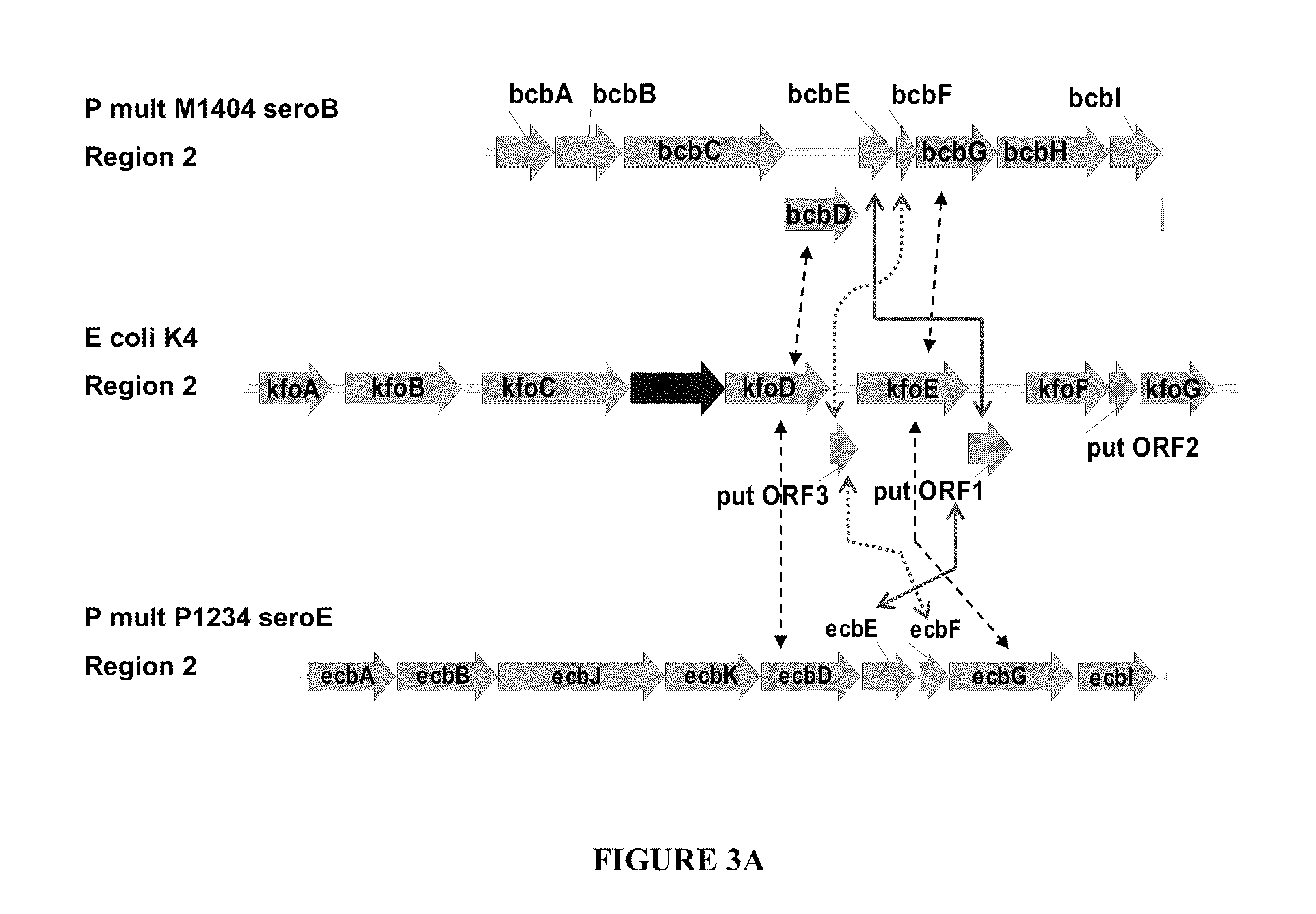Compositions and Methods for Bacterial Production of Chondroitin
a chondroitin and bacterial technology, applied in the direction of dna/rna fragmentation, immunoglobulins against bacteria, peptides, etc., can solve the problems of unsuitable large-scale fermentation, unsuitable for commercial production of chondroitin, laborious and cost-intensive traditional methods of chondroitin sulfate production involving animal tissue purification,
- Summary
- Abstract
- Description
- Claims
- Application Information
AI Technical Summary
Benefits of technology
Problems solved by technology
Method used
Image
Examples
example 1
Genetics of K4 Capsule Biosynthesis
[0164]The E. coli K4 capsule is categorized as a “group 2” capsule. As reviewed by Whitfield (Annu Rev Biochem. 2006; 75:39-68), the synthesis of E. coli group 2 capsules is directed by a set of proteins encoded by gene clusters having a common genetic organization consisting of three regions. The predicted structure (prior to the current invention) of the E. coli K4 capsule gene cluster is shown in the FIG. 2. Region 1 was expected to contain six genes, kpsFEDUCS, and region 3 was expected to contain two genes, kpsM and kpsT. Based on sequence homology with known proteins, kpsF and kpsU genes were predicted to encode proteins that catalyze steps in the biosynthesis of the sugar nucleotide CMP-Kdo. A role of CMP-Kdo biosynthesis of group 2 capsules in E. coli has been proposed (Roberts, Annu. Rev. Microbiol. 1996; 50:285-315) but has not been demonstrated experimentally (Whitfield, Annu Rev Biochem. 2006; 75:39-68). The kpsM, kpsT, kpsD, kpsE, kpsC...
example 2
Synthesis of Codon-Optimized E. COLI K4 Capsule Biosynthetic Genes
[0182]The sequence of the U1-41 K4 capsule gene cluster as determined by the present inventors was used as the basis for the design of synthetic genes to be used for expression in alternative hosts. Synthetic constructs were designed to allow the expression of one or more synthetic operons containing the K4 capsule biosynthetic genes and were optimized for codon usage based on a consensus preferred codon table that employs codons that are acceptable for expression in E. coli, X. campestris, S. elodea and B. subtilis. Table 3A gives codon usage tables for E. coli, X. campestris and B. subtilis genomes as well as for E. coli K4 region 2 genes related to K4P capsule biosynthesis, and 53 S. elodea genes including those related to gellan biosynthesis. This table illustrates the striking use of unfavorable codons in the K4 region 2 biosynthetic genes. These codons are not only extremely unfavorable for X. campestris or S. e...
example 3
Construction of Alternative Host Strains
[0187]The initial alternate hosts chosen for expression of the K4 biosynthetic genes included E. coli K-12 (“K-12”), E. coli. B (“EcB”), Sphingomonas elodea (“Sph”), and Xanthomonas campestris pv. campestris (“Xcc”). K-12 strains W3110 and MG1655 were obtained from the Coli Genetic Stock Center, Yale University. Sph strain ATCC 31461 was obtained from ATCC. Xcc strain NRRL B-1459 (ATCC 13951) was obtained from the ARS Culture Collection (NCUAR), Peoria, Ill. E. coli B (ATCC 11303) was obtained from ATCC.
[0188]In general, the alternate hosts were prepared for introduction of the K4 genes in two ways. It can be advantageous to be able to deliver genes / plasmids to certain alternate hosts by conjugal transfer from laboratory cloning strains of E. coli in tri-parental crosses with E. coli containing the mobilizing plasmid pRK2013. To select for transconjugants of the alternate hosts among the conjugal milieu, antibiotic-resistant derivatives (typic...
PUM
| Property | Measurement | Unit |
|---|---|---|
| Temperature | aaaaa | aaaaa |
| Temperature | aaaaa | aaaaa |
| Time | aaaaa | aaaaa |
Abstract
Description
Claims
Application Information
 Login to View More
Login to View More - R&D
- Intellectual Property
- Life Sciences
- Materials
- Tech Scout
- Unparalleled Data Quality
- Higher Quality Content
- 60% Fewer Hallucinations
Browse by: Latest US Patents, China's latest patents, Technical Efficacy Thesaurus, Application Domain, Technology Topic, Popular Technical Reports.
© 2025 PatSnap. All rights reserved.Legal|Privacy policy|Modern Slavery Act Transparency Statement|Sitemap|About US| Contact US: help@patsnap.com



